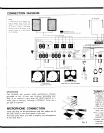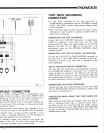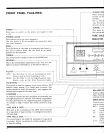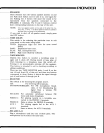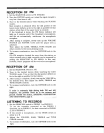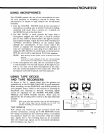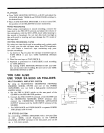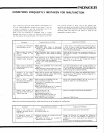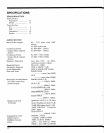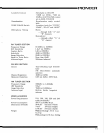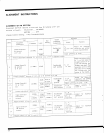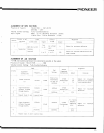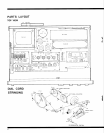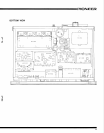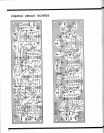
TJIONEEFI
CONDITIONS
FREQUENTLY
MISTAKEN
FOR
MALFUNCTION
Noise: There are
a
variety
of
noises
relating to the operation
of a
from
external
sources of
nolse. Due
to the inherent
high
hi-f
i
unit.
These are
generalty
divided
into two types;
(1)
the unit
amplif
ier and reproduces extraneous
noises into def inite output
is faulty
(a
transistor
or
part
has deteriorated)
and
(2)
an
noise. lf
your
receivel
produces
a
noise, check according tothe
external
sourceof
noise isadding noiseto
the unit.
following table and
trace out
the source of noise
for
the
When a
hi-fi unit
produces
an
unpleasant
noase, it
is
often
appropriate
corrective action.
assumed
that the
unit
is
faulty, but
statistical
records
indicate
that the
maiority of
noises
produced
in hi-f i acoustic
unats
result
Watch for
the
following
conditions; these
are also apt to be mistaken
for malfunction.
SVmptom
Suspected
Source
of Noise
Diagnosis
and
Remedy
a
o
E
o
m
o
g
o
'?
.J
q
o
!
=
Continuous or
intermitten
noise like
jjjjli
or
zzzzzz.
.
Static
(lightning)
o
Fluorescent lamp,
motor, or thermostat
may be
in
use
in house
or
in
the vicinity
of
the house.
In manv cases,
it is
very diff
icult
to
remove
the source
of
noise. In
order
to
make
the radio input larger than
the noise
level,
set up a
good
outdoor antenna and
make a complete
grounding
When a station
is tuned in,
hum is mixed
in the
program.
r Poor fluorescent
lamp,
motor, or
electric
heater may
be
in
use
in house or near the
house.
Reversing the
line
plug
may occasionally alleviate this
noise
problem.
Usually
it is very
difficult
to
eliminate
tne norse.
Hissing sound
noise in
AM
(medium
wave)
reception.
I
The frequency of an adjacent
station is
interfering with that of the station being
tuned in
(10kHz
beat interference).
o TV set
is
on
in the same house with the
rece iver.
lmpossible to remove such interference. lf the cause
of
such
noise is in the
TV
set. increase the
distance
between
the
TV
set
and
receiver.
Static
noise
(in
particular,
when automobiles
run close
to the house).
a
White noise
generated
from automobile
engi
nes.
r Radio frequency
sewing
machine or weld-
ing machine
being
used near
your
house.
In an
area
surrounded by hills or high buildings, the
FM input signals are very weak.
Thus
the noise limiter
in the
circuit
loses its function.
Set
up an outdoor
FM
antenna
having many reflector
elements.
Reception of
FM
stereo
program contains more
noise
than
FM mono
pro-
gram.
a
Note that
the
service area covered by an
FM
stereo broadcast
is
about 50% of
that
of a
regular mono
broadcast.
Increasing
FM input
signal may alleviate
this
problem.
Use
an exclusive FM outdoor antenna
instead
of the
indoor
T-
tvpe
antenna.
E
o
E.
o
.=
o
o
=
Hum
or
buzz. When
switched to radio
reception,
the
noise
disappears.
a
Poor connection of shielded wire
{a).
. Jack connection
is loose.
(b)
o Line cord or
f luorescent
lamo
is near the
shielded wire.
(c)
o
Poor
grounding.
(d)
a
Ham
transmitting station or TV
transmit-
ting station is near
your
house.
(e)
Correcr
the conditions
stated in
(a), (b). (c)
or
(d).
ln
case of
(e),
report it to an ofJicial activity.
Output
tone
quality
is
poor
and mixed with noise.
Treble is not clear.
.
Stylus
is worn out.
(a)
. Record
is
worn out.
(b)
a Dust adheres
to
stvlus.
(c)
.
Stylus
is improperly mounted.
(d)
a Stylus
pressure
is not
proper.
(e)
r
The TREBLE
level is
too
hiqh.
Check
(a)
through
(e)
and correct
the condation.
Lower
the
TREBLE
level.
Symptom Suspected
Source of
Noise
Diagnosis and Remedy
Power is not
turned
on
although the
power
switch
rs
set
to
ON.
o
Fuse
blows.
(a)
. Line
plug
is
loose.
(b)
Check
(a)
and
(b)
and correct
the
condition.
In
playing
a record, in-
creasing the volume
causes
howling.
a
Distance between the turntable
and the
soeakers
is
too short.
a
The
place
on
which the
turntable
or
soeakers are set
is
unstable.
Change
the distance or
rearrange the
installataon
increase of the unit and speakers.
(lnstalling
the
turntable on
a firm, solid stand
may alleviate
this
oroblem.)
Do not enhance
the
BASS
sound
level
excessavely.
TZ



